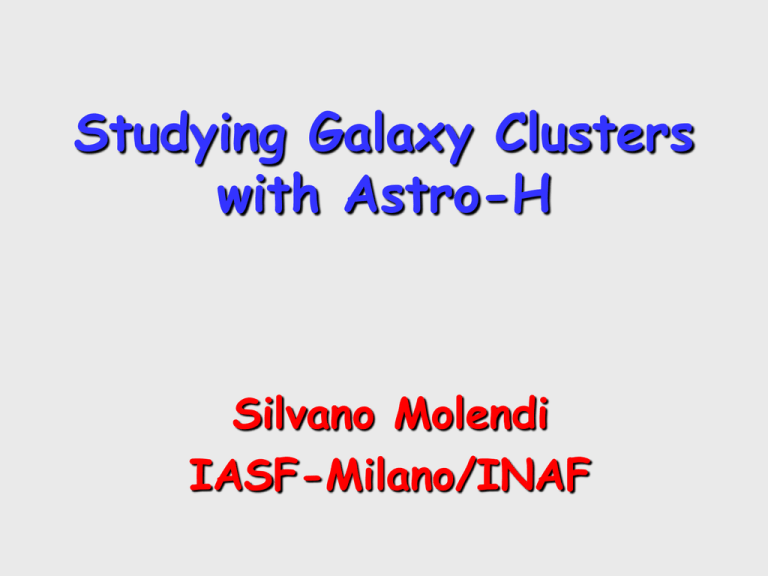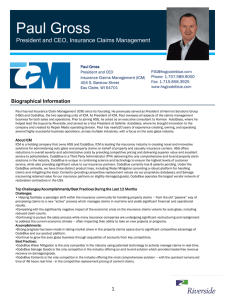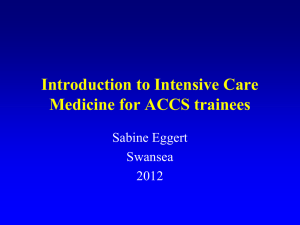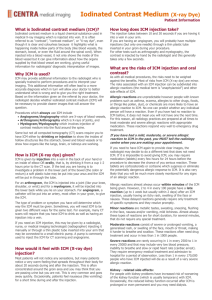Studying Galaxy Clusters with ASTRO-H
advertisement

Studying Galaxy Clusters with Astro-H Silvano Molendi IASF-Milano/INAF ICM in Galaxy Clusters Largest gravitationally bound structures in the local universe. Subject of intense research a) as cosmological tools b) interesting structures a) and b) are of course connected as some understanding of the structures is required to use clusters as cosmological tools. Setting the context Basic properties of the ICM • The ICM is tenuous, typical densities 10-4 to a few 10-2 cm-3 • hot, temperatures from 107 to 108 K (1-10 keV) • highly ionized: H, He completely ionized heavier elements partially ionized Chemically enriched, heavy elements such as O, Si and Fe are present in almost solar proportions • X-ray emission Thermal bremsstrhalung + line emission Setting the context Basic properties of the ICM X-ray emission form clusters is extended ASTRO-H ASTRO-H will carry the first micro-calorimeter We have had high resolution spectroscopy in X-ray for more than decade now, so is ASTRO-H really going to be a major step forward? The large improvement in collecting area at Fe K line will afford considerable insight for many astrophysical sources. However, for extended sources, for which high res. spectroscopy has been possible only in the most limited sense, SXS will produce a true quantum leap The importance of motion Show movies Disclaimer • Many things can and will be done, in this presentation I will cover some of the most important. • Not an exhaustive presentation. Motions in the ICM Indirect evidence of motions is now abundant Shocks in the ICM Bullet cluster Best example of shock Core of sub-structure already gone through cluster From RH conditions and density jump Mach number ~ 3 Vshock ~ 4700 km/s Markevitch & Vikhlinin (2007) Motions in the ICM Shocks now seen in a few systems point to mildly supersonic gas motions These are rare systems, one of the reasons is the shocks occur exactly in the plane of the sky There are likely similar systems seen at different angles (e.g. A576 Dupke+07) these will be accesible with SXS Motions in cores Indirect evidence of gas motions in the cores of many “relaxed” (Cool Core) systems Core of Perseus cluster Highly structured Enhanced emission Cavities Fabian+03 Radio Bubbles Cavities coincide with radio lobes associated to the AGN at the center Fabian+03 Ripples and weak shocks Fabian+03 Radio cavities expand and rise buoyantly, in doing so they set the ICM in motion, generating ripples and weak shocks Cold Fronts Ghizzardi, Rossetti &SM 2010 • CF are contact discontinuities (SB jumps) discovered by Chandra (Markevitch & Vikhlinin 2007) • Found in merging systems where they mark dense subcluster cores that have survived a merger Cold Fronts Ghizzardi, Rossetti &SM 2010 • Found in non merging systems were they result from the displacement of lowest entropy gas from the bottom of the potential well. • Small pressure jump across the CF point to subsonic motions • Search for cold fronts in a representative sample of nearby systems shows that ALL relaxed clusters host at least 1 CF Gas Motions in clusters • Indirect evidence for ubiquitous subsonic gas motion in cluster cool cores • Subsonic motions are quite likely one of the defining traits of these systems, (the reason this statement is seldom made is that we have, thus far, lacked direct observations of gas motions) • Open questions are: what is the kinetic energy vs. thermal energy? is the flow laminar or turbulent? what is the viscosity of the ICM? • Indirect evidence for mildly supersonic motion in a few systems, typically those were shock is propagating in the plane of the sky. SXS on ASTRO-H • A 6eV resol @ Fe Kα line corresponds to a velocity resolution of 300 km/s • The sound speed in the ICM is cs = (5/3·p/ρ)1/2 = 1460 km/s·(kT/8 keV) 1/2 ASTRO-H well suited to measure subsonic motions in ICM • Most important line is the Fe Kα • For most T He-like Fe Kα is the most prominent Fe He-like Kα Laminar flow Different regions with Δv=200km/s Turbulent flow Region with vTurb=200km/s Laminar vs Turbulent flow • Some line broadening may be present even if turbulence is completely absent (limited angular resolution & line of sight effects) • The combination of high spectral resolution and moderate angular resolution should allow us to distinguish between flows dominated by laminar and turbulent motions. • Intermediate cases will be more difficult but not impossible to characterize. ICM Thermo-dynamic structure • XMM-Newton Grating (Peterson+01 ) and CCD data (SM & Pizzolato 01) falsified the cooling-flow model that predicted strong multi-phaseness of ICM in cluster cores (temperatures from a few keV down to 0.1 keV). • Evidence, in some instances, of suppression of conduction, presence of multi-temperature structure: 1. suppression of conduction across cold fronts e.g. A3667, Ettori & Fabian 2001 2. presence of blobs/filaments of cooler gas in the radio arms of M87 (SM 2002, etc.) ICM Thermo-dynamic structure The limited spectral resolution of CCDs and spatial resolution of gratings does not allow us to address the issue of moderate multi-phaseness in the ICM at large SXS will change this ICM Spectra at CCD resolution ―1 ―2 ―4 ―8 keV keV keV keV ICM Spectra at SXS resolution ―1 ―2 ―4 ―8 keV keV keV keV Fe L-shell emission T up to 3keV Ar Kα line emission He-like H-like Ratio of H to He-like 2keV <T < 8keV Fe Kα line emission He-like H-like Ratio of H to He-like 2keV <T < 10keV ICM Thermo-dynamic structure • The relative intensity of Fe L-shell lines and the ratio of H-like Kalpha to He-like Kalpha lines for O,Mg,Si,S,Ar,Ca & Fe are all dependent upon temperature and can be used to provide independent estimates of T and assess presence of even modest multiphase-ness. • As for the study of line broadening some apparent multi-T will be present even if the gas is single phase (limited angular resolution & line of sight effects), however these effects can be accounted for Summary The SXS will produce a quantum leap in our understanding of the ICM It will: directly detect motions within the ICM for the first time characterized the thermodynamic structure of the ICM improve our understanding of metals in the ICM NuSTAR • The relative intensity of Fe L-shell lines and the ratio of H-like Kalpha to He-like Kalpha lines(FWHM) for 10 arcsec O,Mg,Si,S,Ar,Ca & Fe are all dependent 13 x upon 13 arcmin temperature and can be used to provide1 keV independent @ 60 keV estimates of T and assess presence of 0.5 even keV @modest 6 keV multiphase-ness. • As for the study of line broadening some apparent multi-T be present even if turbulence is the gas is single phase (limited angular resolution & line of sight effects), however these effects can be accounted for < 48 h NuSTAR • Launched on June 13th in LEO • First Light on June 28th • Thus far everything has gone well • Mast deployment successful • Instruments functioning within expectations








